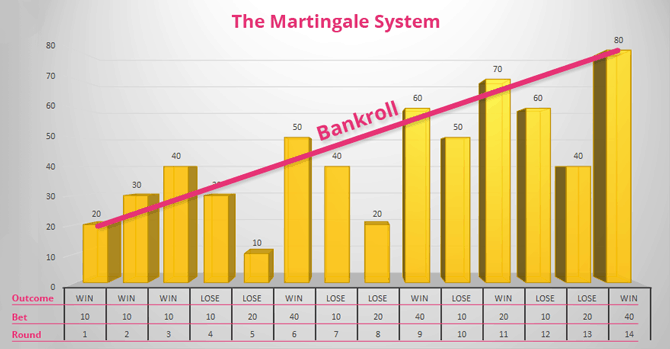Gamblers all around the world are continually seeking to find new ways to gain an advantage over the casino. Accordingly, one common belief with many players is that by using various popular strategies, you can effectively boost your chances of a massive win.
Among the most famous strategies which seem to have survived not just time, but also the transitioning of ‘land-based’ casinos to the modern online platforms is the ‘Martingale System.’
Primarily, its remarkable popularity perhaps stems from its distinct simplicity and its rather deceptive appeal of efficiency. Want to know more about this system? Here is everything on the famous Martingale Betting System.
Definition: What is it?
The unique Martingale System is among the oldest systems of betting and is widely considered to date back to the 18th century in Europe, where casinos first gained popularity.
Fundamentally, this distinct system is a notion based on the belief that an event is more likely to happen because it has not happened in a substantial while. Like all other progressive systems, it shares a similar assumption as the famous Gambler’s Fallacy concept of belief that random events are more or less likely to occur following a given activity or a series of events.
The primary difference, however, and arguably the reason behind its popularity is its exclusive doubling up method after every loss, rendering it quite easy to calculate the progressions. However, Martingale is a select negative progression method meaning that you need not double after each win. Rather, after a success, you will need to place your bet using your base stake.
Origins
While The Martingale system is majorly considered to have begun in Europe back in the 18th century during the onset of casinos, this system gained global popularity courtesy of John Martindale, who owned a casino in London.
Martindale was profoundly persuaded that the house edge of the casino managed to effectively combat most of the player’s winning pursuits to the extent that he regularly encouraged the players to use the double-up strategy to succeed from their losses while playing in his London-based casino.
How Does It Work? Principals and Example of the Martingale System at Work
The underlying concept of the Martingale System is quite simple. When playing, you increase your bet after each loss, and as such, on eventually winning, you recover your lost stake and begin betting with your initial stake amount. This is the primary reason why this system mandates that you double your bet stake after your loss in efforts to regain your lost money.
Essentially, you start your bet with a small stake (table minimum, preferably) and continue betting a similar stake until you finally lose. Once you lose, you then double your stake for your next bet. This way, in the event you win, you can recover what you lost on your previous bet, and possibly win an extra amount on top.
Similarly, in case you continue losing, you continue to double your bet. After you win, you must restart and stake the smallest amount (or your initial base stake) on your next bet. Rinse and Repeat!
It uses two primary principals:
- Double up each time you lose: If you stake $5 and lose, you should place a $10 on your next round. In case you lose again, you should then bet $20.
- Stick to your base stake when you win: The negative progression nature of the Martingale means that on winning, you need not double up. Instead, after a win, you revert to betting your base stake.

Example
To better understand the underlying concept of this system, let’s consider this example:
Let’s assume you are playing a coin toss game where you can bet for either tails or heads, and you start with an initial stake of $10 and $100 as your total wager. The probability of the coin falling on either heads or tails is 1:1, with every coin flip being independent of the other. This means that your last flip has no impact on how the next flip plays out.
Say you place your bet on tails, and you win, meaning you now have a total of $110. With every success, you continue betting with the same stake ($1) until you eventually lose.
Your next toss losses and your stake goes back to $100. So, on your next bet, you double your bet to $20 with the hope that the coin will land on tails, you will effectively recover your previous losses, and your net loss and profit goes to zero. Unfortunately, the coin lands on heads again, and you subsequently lose another $20, cutting down your wager total to $80.
Considering the martingale system, on your next bet, you place double your previous stake to $40. Luckily, you win and gain $40, taking your total funds to $120. Ideally, looking at this instance, all you need is one win to cover all the losses before.
Why is the Martingale System So Popular?
Over a century after the Martingale betting system was conceived, this system did prove as significantly successful for Charles Wells. He applied this system when playing a roulette game, and he effectively managed to outshine the casino by remarkably breaking the bank 12 times in just three days in the famous Monte Carlo Casino. Well’s momentous one million francs win astoundingly came from his initial investment stake of 4000 francs.
Advantages
- Relatively Easy understand and use
- You control your base stake
- Freedom to stake as high or low as you wish
- Generates short-term profits
Disadvantages
- Exponential increase of your bet size
- Has no impact on the house edge
- Mandates for vast amounts of money to gain profits
- Small benefits for a significantly big risk
- Hard to identify when to stop playing
- Possibility of reaching the standard Table Limit
The Martingale Betting System and Online Betting Strategies
In the end, it cannot hurt to try the Martingale System in your online gambling strategy. However, if you were to use this approach, you must consider two factors: the amount of money you want to wager as well as whether the outcome will be profitable.
Ideally, for a given period (perhaps), the Martingale strategy will provide you with small profits. Nonetheless, in the long run, especially considering its steep progression characteristic, this system can be severely risky. In due course, each gambler has the experience to forget when using Martingale.
We’ve given you a fair warning in advance!


